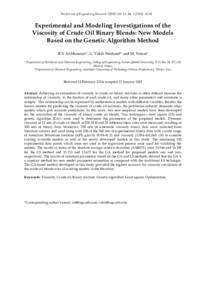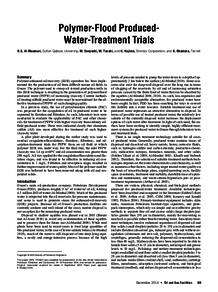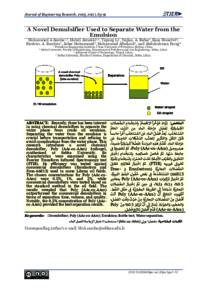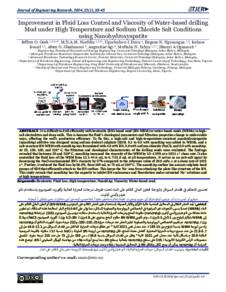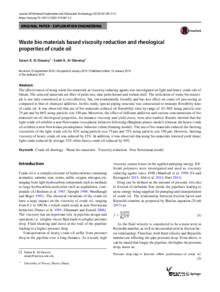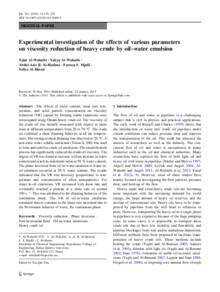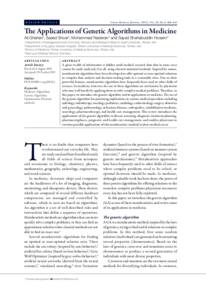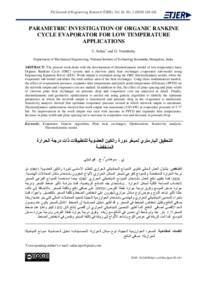وثيقة
Experimental and modeling investigations of the viscosity of crude oil binary blends new models based on the genetic algorithm method.
المساهمون
Vakili-Nezhaad, G., مؤلف
Vatani, M., مؤلف
الناشر
Sultan Qaboos University
ميلادي
2015
اللغة
الأنجليزية
الملخص الإنجليزي
Achieving an estimation of viscosity in crude oil binary mixtures is often difficult because the relationship of viscosity, to the fraction of each crude oil, and many other parameters and constants is comply. This relationship can be expressed by mathematical models with different variables. Besides the known models for predicting the viscosity of crude oil mixtures, the petroleum industry demands other models which give accurate predictions. In this work, two new empirical models have been developed for the calculation of the viscosity of binary crude oil blends. Two techniques—least square (LS) and genetic algorithm (GA)—were used to determine the parameters of the proposed models. Dynamic viscosity of 12 sets of crude oil blends at 298.15 K and 25 different shear rates were measured, resulting in 300 sets of binary data. Moreover, 700 sets of kinematic viscosity binary data were collected from literature sources and used along with 200 of the 300 sets of experimental binary data with a wide range of American Petroleum Institute (API) gravity (9.89–41.2) and viscosity (1.054–165,860 cSt) to examine existing available models as well as the newly developed models in this study. The remaining 100 experimental data points which were not used in the regression process were used for validating the models. The results in terms of the absolute average relative deviation (AARD%) were 33.546 and 14.195 for the LS method and 13.113 and 13.672 for the GA method for proposed models one and two, respectively. The results of statistical parameters based on the GA and LS methods showed that the GA is a superior method for new model parameter estimation as compared with the traditional LS technique. The GA-based models developed in this study provided the highest accuracy for viscosity calculation of the crude oil blends over all existing models in the literature.
المجموعة
ISSN
1726-6742
URL المصدر
zcustom_txt_2
Al-Maamari, R. S., Vakili-Nezhaad, G., & Vatani, M. (2015). Experimental and modeling investigations of the viscosity of crude oil binary blends: new models based on the genetic algorithm method. The Journal of Engineering Research, 12 (1), 81-91.
الملخص العربي
غالبا ما تشمل عملية تقدير لزوجة النفط الخام ثنائي الخلط درجة من الصعوبة نظرا لتعقيد دالة اللزوجة ووجود جزء من النفط الخام وبارمترات أخرى متعددة وثوابت. يمكن التعبير عن هذه العلاقة باستخدام نموذج رياضي بمتغيرات مختلفة، بجانب النماذج المعروفة للتنبؤ بلزوجة خليط النفط الخام تعتمد صناعة البترول على نماذج أخرى تعطي تنبؤات أدق. في هذا العمل تم تطوير عدد نموذجين تجريبيين جديدين لحساب اللزوجة للنفط الخام الممزوج. استخدام في كلا النموذجين طريقة أقل مربع و طريقة الخواريزم الجيني لتحديد البارمترات الخاصة بالنموذج المقترح تم قياس اللزوجة الديناميكية لعدد 12 مجموعة من النفط الخام الممزوج على درجة حرارة 298.15 كيلفن و 25 معدل قص مختلف وأسفرت عن عدد 300 من البيانات الثنائية، علاوة على ذلك تم جمع عدد 700 مجموعة من اللزوجة الحركية للبيانات الثنائية من مصادر المراجع وتم استخدامها في 200 حالة من 300 من البيانات الثنائية التجريبية مع نطاق كبير من جاذبية API (من 9.89 حتى 41.2 ) ولزوجة (من 1.054 حتى 165.860 cSt) لاختبار الموجود والمتوفر واختبار أيضا النماذج المطورة في هذه الدراسة. تم استخدام عدد 100 نقطة من البيانات التجريبية المتبقية التي لم يتم استخدامها في عمليات الانحدار للتحقق من صحة النماذج. النتائج التي تم الحصول عليها من حيث %AARD هي 33.546 و 14.195 لطريقة أقل مربع و 13.113 و 13.672 لطريقة الخوارزم الجيني للنماذج المقترحة 1 و 2 على الترتيب. أظهرت النتائج لإحصائيات البارمترات التي تعتمد على طرق الخواريزم الجيني وأقل مربع تفوق طريقة الخوارزم الجيني لتقدير البارمترات للنماذج الجديدة مقارنة بنموذج أقل مربع التقليدي. قدمت نماذج الخواريزم الجيني التي تم تطويرها في هذه الدراسة أعلى دقة في حساب لزوجة النفط الخام الممزوج مقارنة بكل النماذج المقدمة في المراجع.
قالب العنصر
مقالات الدوريات

